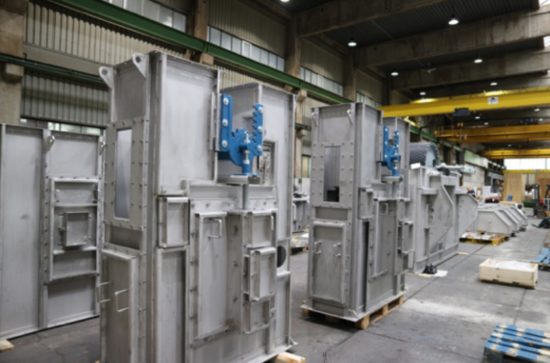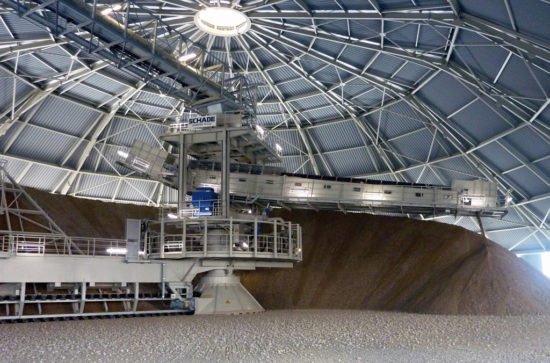AUMUND NEWS 3//2021 – Products. Projects. Progress
AUMUND Fördertechnik
Bucket Elevators with Special Features
Best Choice for Vertical Transport of Alternative Fuels
Cement, steel and power production are three of the most energy-intensive industries in the world today, as they continue to use a high proportion of fossil fuels in their processes, releasing carbon dioxide and polluting the environment. These industries are now being forced to comply with increasingly stringent local and international legal requirements in order to reduce their CO2 emissions. As alternative fuels play a significant role in achieving these targets, the AUMUND Group has intensified the development of its strategic activities in this high-potential sector.
At EU-level, the “European Green Deal” is regarded as the path to a sustainable EU economy. The overriding aim of the concept is that net greenhouse gas emissions are reduced to zero by 2050, and therefore the EU becomes carbon neutral. One of the most important initiatives of the Green Deal is the climate protection law that was introduced in March 2020. It requires EU emissions of CO2 to be reduced by 50 to 55 percent by 2030 compared to 1990. On this journey, the use of all kinds of refuse as alternative fuels in energy-intensive industrial processes will become more and more important.
Environment meets technology
Alternative fuels can be divided into two groups. The first is biomass, which comprises among other things wood chips, wood pellets, sunflower seeds, coconut shells, soiled straw or hay, and sewage sludge. Biomass is carbon neutral because when burnt, it is only re-releasing the CO2 that it had taken out of the atmosphere whilst growing or being produced.
The second large group is comprised of materials such as plastics, tyres, medical refuse, shredded paper, bone meal, and waste from textile manufacturing. In many countries it is no longer permitted to dump plastics, but as the possibilities for recycling are limited, plastic is an appropriate alternative fuel.
A particularly suitable application presents itself in the cement industry, where high-temperature processes break up the long chain hydrocarbons, which would normally be released by incineration and can cause health hazards.
AUMUND technology meets market requirements
The AUMUND Group offers a wide range of products and has sold over 1,000 pieces of equipment for the handling and conveying of alternative fuels to many different parts of the world. For vertical conveying of bulk materials, the AUMUND Group has been manufacturing belt and chain bucket elevators for more than six decades, with close to 10,000 supplied to date. A significant number of these bucket elevators have been designed specifically for alternative fuels.
Over time AUMUND bucket elevators have, as a result of their proven quality, strength and reliability, become the industry standard for efficient vertical conveying of various materials. Typically, AUMUND bucket elevators operate with a combination of centrifugal and gravity discharge. Pure gravity discharge bucket elevators are also part of the Group’s range, but play only a minor role in the handling of alternative fuels. The classic bucket elevator has proved to be an optimal solution in terms of footprint, capital investment and operating costs.
The choice of whether to use a belt bucket elevator or a chain bucket elevator is dependent on the properties of the material to be conveyed. Belt bucket elevators are recommended for fine grained, cold and corrosive products and for those containing no oil. For the other end of the spectrum: coarse, hot, abrasive and oily materials, chain bucket elevators are used. Both types of bucket elevator can be equipped with a range of different buckets. Standard buckets are made of mild steel, which can be reinforced with stiffening plates or strengthened lips if the material is very coarse. For extremely abrasive materials the buckets are equipped with liners made of HARDOX or a similar material, in order to extend the lifetime of the buckets.
Bucket elevators in stainless steel
Fabricating the buckets in stainless steel has produced very good results with sticky and cohesive materials. This has been taken one stage further by the AUMUND development of buckets with a rubber base.
Characteristically, extremely sticky materials tend to not to be discharged fully from the buckets, and consequently the buckets cannot be used to their full volume. With continuing use, more and more material remains in the buckets until they become almost fully blocked. As it is difficult to calculate in the design phase how much adhesive material is going to remain in the buckets, it was particularly challenging in the past to choose the best sizes of the variable system components. To find a solution to this problem, variations with textile belt or plate rubber elements as bucket bases were tested, but with unsatisfactory outcomes until now.

Rubber coated buckets
Now AUMUND has designed a special bucket base in cooperation with a supplier of elastomeric technology. The advantages of using this type of material are that it is highly flexible, very strong, highly resistant to chemicals, and can withstand extremes of temperature and weather influences.
After successful prototype tests, ten test buckets were installed at a German cement plant. The test results confirmed the suitability of a rubber base. A small amount of adhesive material did remain in the buckets, however the residue no longer built up from the corners of the base or the side walls of the buckets.
The result was that the original bucket volume could be maintained with very little deviation. An added advantage was that automatic bucket cleaning became possible. In mid-2019 a bucket elevator with entirely rubber-based buckets was commissioned in Japan, and a year and a half later it is still operating impeccably.
When transporting alternative fuels with bucket elevators, not only the buckets have to be specially adapted. The casings are also manufactured from stainless steel or are coated inside, in order to avoid build-up of sticky or adhesive materials, which would jeopardize the free movement of the buckets inside the casing.
This design also protects the casings against corrosion in cases where the temperature inside the bucket elevator is below the acid dew point, which could likely cause condensation. Also, the inlet and outlet chutes are designed in such way that proper feeding and discharge is ensured under all circumstances and spillage into the boot is avoided.


Bucket elevators for low capacity
Bucket elevators with central chain are usually equipped with a drive ring, incorporating a design which allows for a three-point support of the chain on the ring: one supporting point at the bush and two at the chain links. Bucket elevators for very low capacities, however, have a design which allows higher speeds with reduced wear and lower dynamic loads. If the materials to be conveyed are high in grease, oil and moisture content, a toothed rim can be incorporated into the design. A drive ring would not be suitable because grease or oil could create a lubricating film on the drive ring reducing the friction between chain and ring.
The toothed rim solution has proved to be reliable in ensuring the secure start of a full bucket strand and maintaining a continuous run.
Belt bucket elevators have also been adapted to suit alternative fuel materials. The standard for friction liners on the drive drum is rubber, but ceramic liners have proven to be advantageous especially when handling materials with high moisture content and at short centre to centre distances. Ceramic liners are more resistant to moisture and other influences, resulting in a reduced friction coefficient.
For high velocity conveying
Depending on the material characteristics the conveying speeds can be adjusted either by choosing different drive ring diameters, or by installing a frequency converter on the motor. The variety of alternative fuels is huge, and very often at the beginning of a project the flow properties of the material is not known.
Also, laboratory tests only give an overall idea about the expected flow behaviour, because the samples which can be investigated are not large enough. In order to overcome this uncertainty, the frequency converter allows specific adjustment of the speed according the real properties and flow behaviours of the material. The admissible filling rate is also adjusted according to maximum particle size, in order to ensure reliable feeding and discharge of the material.
If ATEX is required
With some alternative fuels there is a risk of explosion under certain circumstances. Both for bucket elevators with central chain and for belt bucket elevators, AUMUND offers an explosion proof design according to ATEX zone 21 up to an overpressure of 0.5 bar. The casings are specially stiffened and equipped with an appropriate number of rupture discs. All sensors and electrical equipment are also designed according to ATEX. The corresponding certification will be submitted.
Summary
Throughout more than 90 years of industrial construction, AUMUND has been a trendsetter in conveying technology and offers products of high technical standard and solutions for a variety of applications wherever conveying and storing of bulk materials is required. AUMUND Bucket Elevators, tailor made, customized and continuously developed to suit ever increasing plant and process requirements, offer availability combined with performance, flexibility and service life.
Contact
If we can help you with any further information, please use the contact form to get in touch.
You will receive an immediate automated acknowledgement, and we will respond to your enquiry as soon as possible.
Many thanks
AUMUND. SCHADE. SAMSON.








